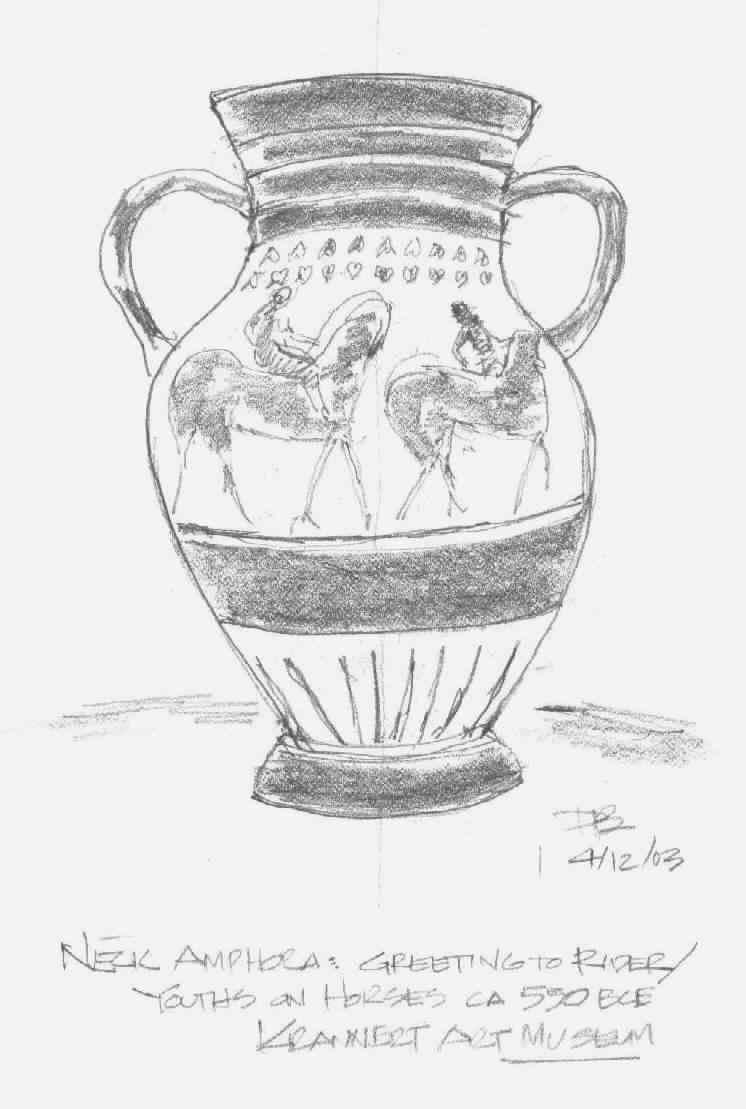Ancient
Background: It is generally recognized that Greek pottery and ceramic skills reached their zenith during the so-called Archaic Period between approximately 600 - 480 BCE. It was during this period that decorated pottery rose above a craft or industrial status into an expressive force that pushed the very limits of the artistic ambition of the time. Now that “pottery vessels no longer served as grave monuments (which are now made of stone),...(the) painted decoration...shows a far greater emphasis on pictorial subjects...scenes from mythology, legend, and everyday life appear in endless variety...”[1]
And artists, instead of remaining anonymous crafters, now began signing their works indicative of the pride of their accomplishments and the value the public placed on their individual artistry.

Artist Name, Title, Date, Media, Context, Intent: The
Formal Properties: Since this was a “black-figure” style ceramic work, its typical decorative features are silhouetted as dark figuration against the typical rust or red-orange naturally-occurring clay background, as opposed to the later and predominately popular “red-figured” technique which reversed this coloration scheme. These dark areas were achieved through the application of “engobe,” a slip of finely-sifted clay that turns darker during the various and exacting phases of the firing process.
This particular amphora solidly stands about 14” high and 9” wide. Although intact in its original form and appearing in good shape for an artifact around 2,500 years old, its slightly chipped and marred finish gives a hint of its advanced antiquity. Its base of deep umber, known as a reversed echinus, is akin to an upside-down tea saucer, upon which the swelling form of the vessel rests; from this base the body of the piece bursts forth in immediacy like a hot-air balloon, its diameter increasing until reaching a height slightly below the top third of the vessel, then reversing in a gently angled short taper to the base of the necking. The neck then flares out to the wide mouth at the top of the jar. Black ear-like handles grace both sides of the vessel, each attaching at the base of the neck and then a little further down on the body just above its maximum swell where it begins to curve inward toward the neck.
A third of the way up the swelling body a wide dark band circles the vessel, dividing this amphora's burnt-orange background (its particular tint indicative of a clay indigenous to the Athens region and hence its “Attic” designation) into a large upper field and a narrow lower field where black rays spike upward from the base. The upper field, which conventionally holds the main subject of amphora decorations, shows a youth riding a horse, leading another horse with a person behind and another person in front perhaps greeting the rider (the “A” side), and two youths riding horses (the “B” side).
The arrangement and placement of the figuration in the larger field achieves an artistic objective of emphasizing and following the contours of the body’s swell. Above the figures and horses, just below the beginning of the neck, a double row of reversed ivy bands resembling tiny “spades” alternating in blue and deep russet surround the vase. The russet coloration also appears in one of the riders and in a horse’s mane. Lettered inscriptions are scattered around the horses on the background.
Comparison: The figures and horses in this vase are a rendered like
a similar vase representation from the same era such as “Oriental Between Two Horses” (an amphora found at
Evaluation: Knowledgeable evaluation of this piece has found enough tell-tale nuances in the style of decoration and the body of the piece to assign a probability of the work as being from the hand of one of the two artists listed above; but the theme of the scene, or scenes, of horses, riders, and standing figures is uncertain.
One seemingly obvious clue to what the scenes represent - the lettered inscriptions previously mentioned - only add to the mystery: they actually spell nothing. Many vase painters were illiterate - so the letters appear to be nothing more than added decoration to balance the work in some fashion perceived by the artist. The subject matter may also be generic - nude youths (as warriors?) riding horses (one of the riders holds a spear), a bearded man standing behind a horse wearing a himation (a long outer garment), a nude standing youth holding a spear while raising a hand to a rider, possibly in greeting. Suggestions include a “returning-warrior theme” or perhaps a bucolic scene of the horsemanship of which the Greeks were very fond.[6]
Conclusion: This piece is certainly intriguing due to its known antiquity,
its gently distressed condition giving it the patina of age, and a more than
acceptable harmonious and interesting artistic composition. However, in my
estimation it doesn’t have the desirability a piece with superior artistic
endeavors and a more focused and recognizable decorative theme showcasing
the universal subjects of Greek mythology that
- Daniel John Bornt
Champaign, IL
14 April 2003
References: